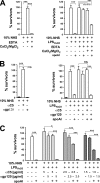Apolipoprotein A-I exerts bactericidal activity against Yersinia enterocolitica serotype O:3
- PMID: 21896489
- PMCID: PMC3207405
- DOI: 10.1074/jbc.M111.249482
Apolipoprotein A-I exerts bactericidal activity against Yersinia enterocolitica serotype O:3
Abstract
Apolipoprotein A-I (apoA-I), the main protein component of high density lipoprotein (HDL), is well recognized for its antiatherogenic, antioxidant, and antiinflammatory properties. Here, we report a novel role for apoA-I as a host defense molecule that contributes to the complement-mediated killing of an important gastrointestinal pathogen, Gram-negative bacterium Yersinia enterocolitica. We specifically show that the C-terminal domain of apoA-I is the effector site providing the bactericidal activity. Although the presence of the lipopolysaccharide O-antigen on the bacterial surface is absolutely required for apoA-I to kill the bacteria, apoA-I does not interact with the bacteria directly. To the contrary, exposure of the bacteria by serum proteins triggers apoA-I deposition on the bacterial surface. As our data show that both purified lipid-free and HDL-associated apoA-I displays anti-bacterial potential, apoA-I mimetic peptides may be a promising therapeutic agent for the treatment of certain Gram-negative infections.
Figures





Similar articles
-
Yersinia enterocolitica serum resistance proteins YadA and ail bind the complement regulator C4b-binding protein.PLoS Pathog. 2008 Aug 29;4(8):e1000140. doi: 10.1371/journal.ppat.1000140. PLoS Pathog. 2008. PMID: 18769718 Free PMC article.
-
The biosynthesis and biological role of lipopolysaccharide O-antigens of pathogenic Yersiniae.Carbohydr Res. 2003 Nov 14;338(23):2521-9. doi: 10.1016/s0008-6215(03)00305-7. Carbohydr Res. 2003. PMID: 14670713 Review.
-
Comparison of lipopolysaccharide and protein immunogens from pathogenic Yersinia enterocolitica bio-serotype 1B/O:8 and 2/O:9 using SDS-PAGE.Biomed Environ Sci. 2012 Jun;25(3):282-90. doi: 10.3967/0895-3988.2012.03.005. Biomed Environ Sci. 2012. PMID: 22840578
-
Oxidation of methionine residues to methionine sulfoxides does not decrease potential antiatherogenic properties of apolipoprotein A-I.J Biol Chem. 2000 Jun 30;275(26):19536-44. doi: 10.1074/jbc.M000458200. J Biol Chem. 2000. PMID: 10751387
-
Significance of Lipid-Free and Lipid-Associated ApoA-I in Cellular Cho-lesterol Efflux.Curr Protein Pept Sci. 2017;18(1):92-99. doi: 10.2174/1389203717666160713150223. Curr Protein Pept Sci. 2017. PMID: 27412400 Review.
Cited by
-
Comparative Whey Proteome Profiling of Donkey Milk With Human and Cow Milk.Front Nutr. 2022 Jun 27;9:911454. doi: 10.3389/fnut.2022.911454. eCollection 2022. Front Nutr. 2022. PMID: 35845789 Free PMC article.
-
Proliferation and resistance difference of a liver-parasitized myxosporean in two different gynogenetic clones of gibel carp.Parasitol Res. 2014 Apr;113(4):1331-41. doi: 10.1007/s00436-014-3772-5. Epub 2014 Feb 1. Parasitol Res. 2014. PMID: 24488077
-
High-Density Lipoproteins: A Role in Inflammation in COPD.Int J Mol Sci. 2022 Jul 23;23(15):8128. doi: 10.3390/ijms23158128. Int J Mol Sci. 2022. PMID: 35897703 Free PMC article. Review.
-
Nosocomial infections after severe trauma are associated with lower apolipoproteins B and AII.J Trauma Acute Care Surg. 2013 Apr;74(4):1067-73. doi: 10.1097/TA.0b013e3182826be0. J Trauma Acute Care Surg. 2013. PMID: 23511146 Free PMC article.
-
Leptospiral LruA is required for virulence and modulates an interaction with mammalian apolipoprotein AI.Infect Immun. 2013 Oct;81(10):3872-9. doi: 10.1128/IAI.01195-12. Epub 2013 Aug 5. Infect Immun. 2013. PMID: 23918777 Free PMC article.
References
-
- Singh I. P., Chopra A. K., Coppenhaver D. H., Ananatharamaiah G. M., Baron S. (1999) Antiviral Res. 42, 211–218 - PubMed
-
- Pérez-Morga D., Vanhollebeke B., Paturiaux-Hanocq F., Nolan D. P., Lins L., Homblé F., Vanhamme L., Tebabi P., Pays A., Poelvoorde P., Jacquet A., Brasseur R., Pays E. (2005) Science 309, 469–472 - PubMed
-
- Hubsch A. P., Casas A. T., Doran J. E. (1995) J. Lab. Clin. Med. 126, 548–558 - PubMed
Publication types
MeSH terms
Substances
Grants and funding
LinkOut - more resources
Full Text Sources
Medical
Molecular Biology Databases
Research Materials

